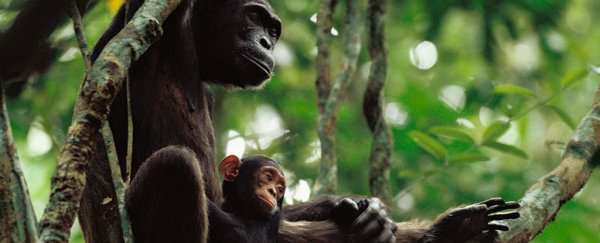Chimpanzees are known for being one of the most adept tool-using species in the animal kingdom, but where do they pick up this complex ability to manipulate physical objects?
For the first time, scientists have filmed chimps in the process of learning how to use tools, and it turns out they get schooled just like us in how to handle implements from that ever-reliable fountain of wisdom: mothers.
"Wild chimpanzees are exceptional tool users, but in contrast to humans, there has been little evidence to date that adult chimpanzees teach youngsters tool skills," says anthropologist Stephanie Musgrave from Washington University in St. Louis.
To find if this teaching behaviour took place in the wild, Musgrave's team set up remote cameras around termite mounds in the Nouabalé-Ndoki national park in the Republic of Congo.
Why termite mounds? Because one of the things chimps eat is termites, although it only accounts for a small portion of their overall diet.
In fact, famed British primatologist Jane Goodall first observed chimps using tools to catch termites in the 1960s, with individuals stripping leaves off twigs and using them like fishing rods to snare termites in the ground.
This episode became the first documented instance of scientists observing tool use by non-human animals.
Musgrave's team wanted to see how wild chimps develop this kind of rod fashioning and usage, so they set up their camera traps in the southern end of Nouabalé-Ndoki, in an area called the Goualougo Triangle.
"In this population, chimpanzees select specific herb species to make their fishing probes, and they produce probes that have a particular brush-tipped design," says Musgrave.
If you're thinking those distinctive touches in the art of termite catching probably need to be passed on from one generation to the next – rather than individual chimps figuring it all out by guesswork – you're not wrong.
"We found that mother chimpanzees in the Goualougo Triangle teach by transferring termite-fishing probes to their offspring," says Musgrave. "By sharing tools, mothers may teach their offspring the appropriate material and form for manufacturing fishing probes."
You can see the tool sharing at work in the videos below, where mother chimps variously prepare, divide, and transfer fishing probes – even handing them over when infants beg:
While the fishing probe preparation and sharing might not look like a big deal, it does come at a cost for the mothers – whose own feeding time ends up being cut down by showing junior the ropes.
"Tool transfers are costly for mothers, whose ability to forage for termites is reduced," says Musgrave, "but are beneficial for offspring, who gain increased opportunity to learn tool skills and gather termites."
And it's this cost-benefit breakdown that demonstrates that what we're seeing here is actual 'teaching' in the animal kingdom.
"These transfers meet functional criteria for teaching: they occur in a learner's presence, are costly to the teacher, and improve the learner's performance," the researchers write in their paper.
Improving the learner's performance – even in this very small task – could make all the difference in the wild, because if the offspring can't learn how to successfully forage for termites, it could mean the difference between life and death when other food sources become scarce.
Tool usage demonstrated by animals goes beyond foraging techniques, too, and includes other actions necessary for survival in the wild. Earlier in the year, researchers in Rwanda even observed young gorillas dismantling poachers' traps – the first time such behaviour had been witnessed in juveniles.
"It is easy for us to take for granted the importance of sharing information to learn complex skills, as it is ubiquitous in humans," says one of the team, Crickette Sanz.
"Our research shows that the evolutionary origins of this behaviour are likely rooted in contexts where particular skills are too challenging for an individual to invent on their own."
The findings are reported in Scientific Reports.
